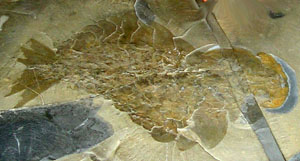Canadian and UK geologists have revealed one of the inner secrets of rocks half a billion years old that harbour one of the most important fossil beds in the world – the Burgess Shales in the Canadian Rockies – in which even soft tissues have been fossilized.
These rocks once formed an ancient sea bed that teemed with life during the Cambrian explosion, a time during which life’s diversity exploded. Now, Sarah Gabbott and Jan Zalasiewicz of the University of Leicester working with Desmond Collins of the Royal Ontario Museum have figured out how the Burgess Shales so successfully preserved the soft parts of ancient animals that are usually lost during the process of fossilization. Bones, teeth, and shells are usually all that is preserved in fossils but the soft parts of millions of plants and invertebrate animals that once existed left no trace in the fossil record.

Dr Sarah Gabbott
The Burgess Shales, discovered in 1909, preserved soft tissue in exquisite detail, a fact that has confound scientists ever since. Now, painstaking work by the Canadian-UK team may have unearthed an answer. The researchers published details of their studies in the Journal of the Geological Society and explain how they analysed the shales millimetre by millimetre.
In their investigation, the researchers found a quite unique geological property of the shales, which might explain their preserving prowess. They found that unlike most rocks of a similar type, the Burgess shales were not slowly deposited, mud flake by mud flake. Instead, the team reasons that the shales were probably formed quickly as a thick slurry powered down a steep slope. This mud slide would have buried instantly myriad animals so deep that the normal processes by which soft tissue are lost – decay, in other words – could not occur. The shales thus froze in a moment in time even the soft tissues. It’s perhaps not a nice way to go, says Gabbott, but it would have been a swift one, and one that has guaranteed immortality of a sort for these strange creatures.

Anomalocaris, one of the myriad strange creatures preserved in the Burgess Shales (Credit: Royal Ontario Museum)
Further reading
J. Geol. Soc., 2008, 165, 307-318;
http://dx.doi.org/10.1144/0016-76492007-023
Dr Sarah Gabbott homepage
http://www2.le.ac.uk/departments/geology/extranet/staff/academic-and-research-staff/sg21
Suggested searches
Burgess shale
fossils